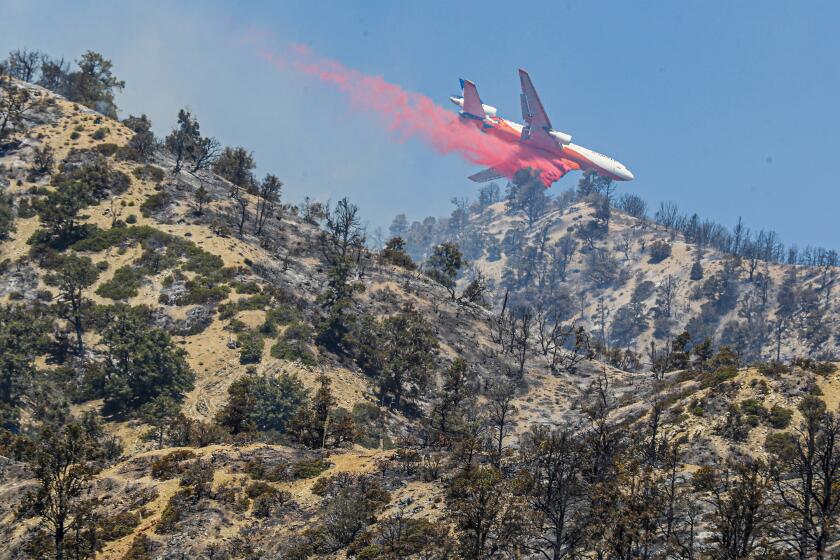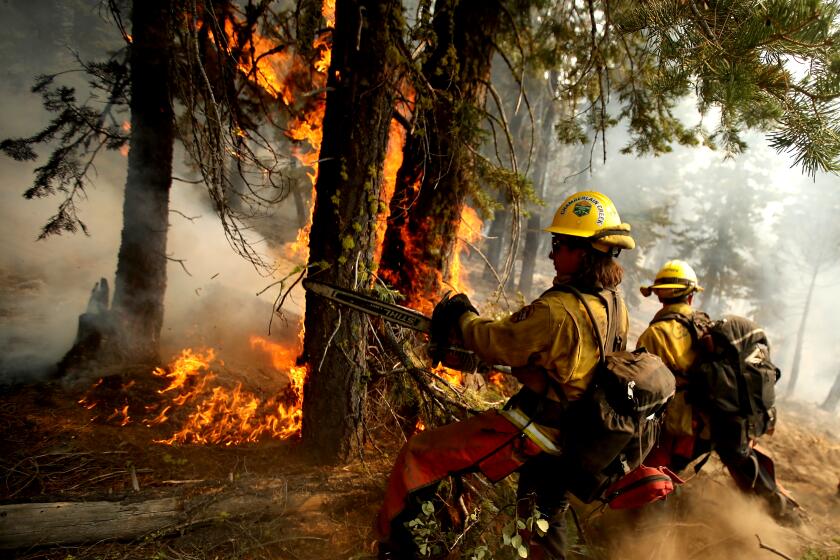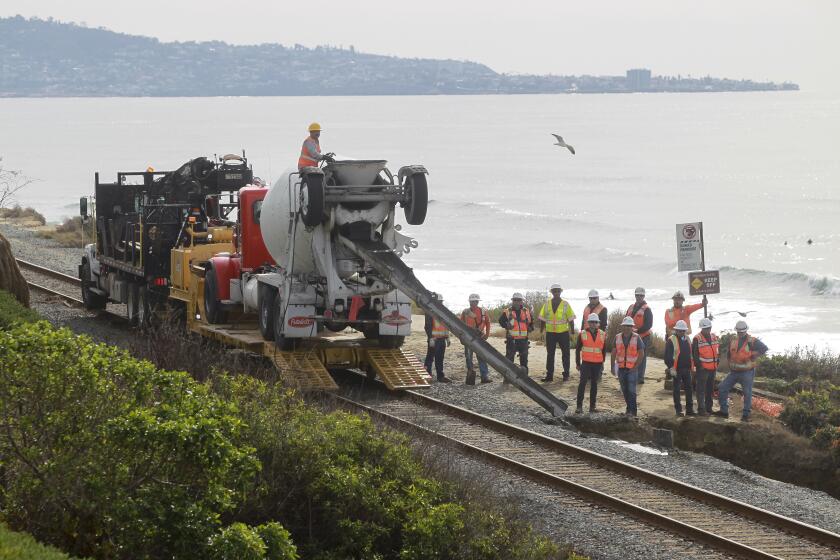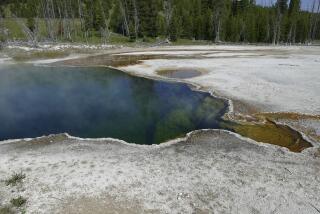Yellowstone flooding forces 10,000 to leave national park
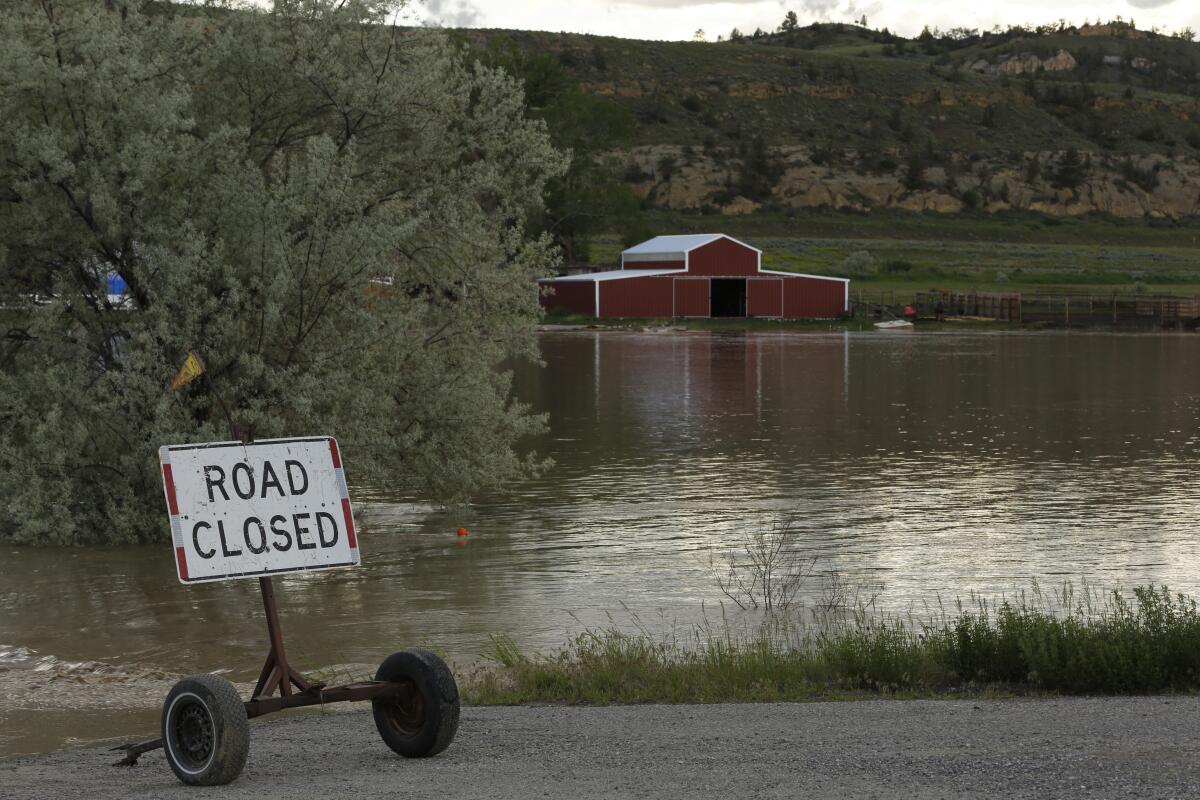
- Share via
RED LODGE, Mont. — More than 10,000 visitors were ordered out of Yellowstone National Park as unprecedented flooding tore through its northern half, washing out bridges and roads and sweeping an employee bunkhouse miles downstream, officials said Tuesday. There were no reports of injuries or deaths.
The only visitors left in the nation’s oldest national park, which straddles three states, were a dozen campers still making their way out of the backcountry.
The park, which celebrates its 150th anniversary this year, could remain closed for as long as a week, and northern entrances may not reopen this summer, Superintendent Cam Sholly said.
“The water is still raging,” said Sholly, adding that rain forecast for this weekend could cause additional flooding.
Southern California officials warn residents that drought and extreme heat are creating conditions for a potentially treacherous fire season.
The flooding hit historic levels in the Yellowstone River after days of rain and rapid snowmelt and wrought havoc across parts of southern Montana and northern Wyoming, where water washed away cabins, swamped small towns, knocked out power and flooded homes. The flooding hit the park just as the summer tourist season, which draws millions of visitors annually, was ramping up.
Instead of marveling at the sight of grizzly bears and bison, burbling thermal pools and the regular blast of Old Faithful’s geyser, tourists found themselves witnessing nature at its most unpredictable as the Yellowstone River crested in a chocolate-brown torrent that washed away anything in its path.
“It is just the scariest river ever,” Kate Gomez of Santa Fe, N.M., said Tuesday. “Anything that falls into that river is gone.”
The full extent of the destruction wasn’t known Tuesday as the waters were starting to recede.
Sholly said backpackers who remained in the park had been contacted. Crews were prepared to evacuate them by helicopter if needed, he said.
Sholly said he didn’t believe the park had ever before shut down due to flooding.
Climate change, drought and soaring temperatures are setting the stage for another devastating wildfire season, officials say.
Gomez and her husband were among hundreds of tourists stuck in Gardiner, Mont., a town of about 800 residents at the park’s north entrance. The town was cut off for more than a day until Tuesday afternoon, when crews reopened part of a two-lane road that had flooded.
While the flooding can’t directly be attributed to climate change, it came as the Midwest and East Coast sizzle from a heat wave and other parts of the West burn from an early wildfire season amid a persistent drought that has increased the frequency and intensity of fires that are having broader impacts. Smoke from a fire in the mountains of Flagstaff, Ariz., could be seen in Colorado.
Rick Thoman, a climate specialist at the University of Alaska Fairbanks, said extreme weather events are more likely than they would have been “without the warming that human activity has caused.”
“Will Yellowstone have a repeat of this in five or even 50 years? Maybe not, but somewhere will have something equivalent or even more extreme,” he said.
Heavy rain on top of melting mountain snow pushed the Yellowstone, Stillwater and Clark Fork rivers to record levels Monday, according to the National Weather Service.
Officials in Yellowstone and in several southern Montana counties were assessing damage from the storms, which also triggered mudslides and rockslides. Montana Gov. Greg Gianforte declared a statewide disaster.
Some of the worst damage occurred in the northern part of the park and Yellowstone’s gateway communities in southern Montana. National Park Service photos of northern Yellowstone showed a mudslide, washed-out bridges and roads undercut by churning floodwaters of the Gardner and Lamar rivers.
Toward a more sustainable California
Get Boiling Point, our newsletter exploring climate change, energy and the environment, and become part of the conversation — and the solution.
You may occasionally receive promotional content from the Los Angeles Times.
In Red Lodge, Mont., a town of 2,100 that’s a popular jumping-off point for a scenic, winding route into Yellowstone, a creek running through town jumped its banks and swamped the main thoroughfare, leaving trout swimming in the street a day later, under sunny skies.
Residents described a harrowing scene in which the water went from a trickle to a torrent in just a few hours. The water toppled telephone poles, knocked over fences and carved deep fissures in the ground through a neighborhood of hundreds of houses. The power was knocked out but restored by Tuesday, though there was no running water in the affected neighborhood.
Heidi Hoffman left early Monday to buy a sump pump in Billings, but by the time she returned, her basement was full of water.
“We lost all our belongings in the basement,” Hoffman said as the pump removed a steady stream of water into her muddy backyard. “Yearbooks, pictures, clothes, furniture. We’re going to be cleaning up for a long time.”
On Monday, Yellowstone officials evacuated the northern part of the park, where roads may remain impassable for a substantial length of time, Sholly said in a statement. But the rest of the park was also affected, with officials warning of more flooding and potential problems with water supplies and wastewater systems at developed areas.
The rains hit just as area hotels have filled up in recent weeks. More than 4 million visitors were tallied by the park last year. June is one of Yellowstone’s busiest months.
It was unclear how many visitors to the region remained stranded, or how many people who live outside the park were rescued and evacuated.
Mark Taylor, owner and chief pilot of Rocky Mountain Rotors, said his company had airlifted about 40 paying customers over the previous two days from Gardiner, including two women who were “very pregnant.”
Taylor spoke as he ferried a family of four adults who had come from Texas; they wanted to do some more sightseeing before heading home.
“I imagine they’re going to rent a car, and they’re going to go check out some other parts of Montana — somewhere drier,” he said.
The work in Del Mar will include seawalls and beach access projects and is expected to take three years and cost $68 million.
At a cabin in Gardiner, Parker Manning of Terre Haute, Ind., got an up-close view of the roiling Yellowstone River floodwaters just outside his door. Entire trees, and even a lone kayaker, floated by.
In the early evening, he shot video as the waters ate away at the opposite bank, where a large house that had been home to park employees, who had evacuated, was precariously perched.
In a cracking sound heard over the river’s roar, the house tipped into the waters and was pulled into the current. Sholly said it floated five miles before sinking.
In south-central Montana, flooding on the Stillwater River stranded 68 people at a campground. Stillwater County emergency agencies and Stillwater Mine crews rescued people Monday by raft from the Woodbine Campground. Some roads in the area were closed, and residents were evacuated.
The sheriff’s office said it would assess damage when the waters recede.
The Montana towns of Cooke City and Silvergate, just east of the park, were also isolated by floodwaters.
In Livingston, residents in low-lying neighborhoods were told to leave, and the city’s hospital was evacuated as a precaution after its driveway flooded.
Officials in Park County, which includes Gardiner and Cooke City, said extensive flooding throughout the county had made drinking water unsafe in many areas.
The Montana National Guard said Monday it had sent two helicopters to the southern part of the state to help with evacuations.
In the hamlet of Nye, at least four cabins washed into the Stillwater River, said Shelley Blazina, including one she owned.
“It was my sanctuary,” she said Tuesday. “Yesterday I was in shock. Today I’m just in intense sadness.”
The Yellowstone River at Corwin Springs crested at 13.88 feet Monday, higher than the previous record of 11.5 feet set in 1918, according to the National Weather Service.
Yellowstone got 2.5 inches of rain Saturday, Sunday and into Monday. The Beartooth Mountains northeast of Yellowstone got as much as 4 inches, according to the National Weather Service.
More to Read
Sign up for Essential California
The most important California stories and recommendations in your inbox every morning.
You may occasionally receive promotional content from the Los Angeles Times.
